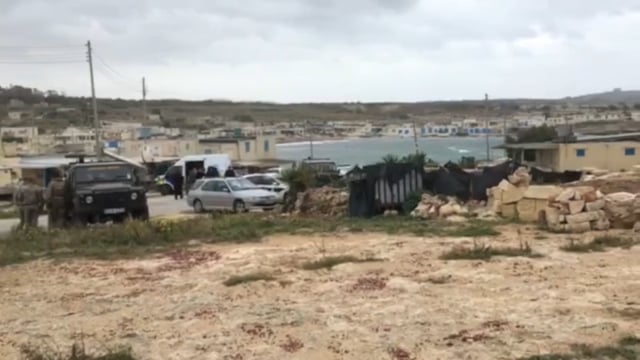[WATCH] Enemalta crackdown on Armier squatters’ electricity theft
100 suspected illegal electricity connections in boathouse removed


Enemalta officials escorted by police officers descended on boathouses in Armier and St Thomas Bay, clamping down on boathouses suspected of energy theft.
Over 100 cases of suspected irregularities were identified and disconnected during the first day of this operation. Further inquiries are underway and will continue this week, Enemalta said.
The move comes after the government allowed boathouse owners to regularise their position, inviting them to apply for a temporary electricity supply in boathouses. Owners had until Thursday of last week to apply for temporary energy supply.
A spokesperson for Enemalta explained that a number of teams have been on site since 8.30am, checking the electrical supply of the boathouses. Those with suspected irregular connections have had their power supply cut.
According to Enemalta’s billing company ARMS Ltd, the temporary supply however does not grant applicants any right or entitlement on the structure in question. The supply would need to be periodically renewed while Enemalta will retain the right to remove the electricity supply with immediate effect and without any obligation or liability for compensation or damages in the event that any authority orders the removal of the structure where it is installed.
Enemalta provides electricity supply to over 500 customers in the L-Aħrax tal-Mellieħa area. These may include agricultural pump rooms, farms, residences, boathouses, commercial establishments and other buildings. The process to replace old meters in this area started when the Automated Meter Management project was launched a few years ago. Over 87% of electricity meters in Malta and Gozo have already been replaced with new smart meters. At Armier, Enemalta replaced over 100 old meters installed in boathouses.
Fredrick Azzopardi, the Company’s Executive Chairman, said that during 2014, Enemalta implemented different measures to curb electricity theft and cut down other non-technical losses.
“We began a major operation to eliminate a serious case of electricity theft involving tampered meters and clamped down on other related irregularities. We investigated every case identified, took all necessary action to recover the revenues lost and passed on the relevant details to the Police for further investigation. We are making it clear that Enemalta will not tolerate electricity theft or other similar abuse.
“A few months ago we also started tackling electricity irregularities in boathouses. We took stock of all authorised connections installed by Enemalta in these areas in previous years. We then gave a one-month option for individuals who did not have a regular connection to apply for a temporary supply of electricity against payment of the applicable fees and deposits. We are now inspecting these areas to make sure that all irregularities are removed.”
Enemalta said it will continue to take all necessary actions to safeguard its interests and to reduce electricity theft and other related irregularities.
“Individuals who are aware of any irregularity may pass on the related details to the Company by contacting its Customer Care team on 8007 2224 or [email protected]. They can also report these irregularities anonymously through the Enemalta website www.enemalta.com.mt.”
Back in February 2013, the environment planning tribunal had turned down an appeal by Enemalta to renew a permit for a substation at St Thomas Bay.
The EPT in fact had said that the substation would be “built to supply electricity to its clients who built illegally and in outside-development zones”, adding that one of the fundamental principles of the Structure Plan, Malta’s planning guide, was that no buildings were allowed outside development zones except those related to agriculture.
Filed in 2010, the original application was refused in 2011 after MEPA said it was “unacceptable”, because “no further intensification to the area will be allowed” before an action plan for St Thomas Bay was yet finalised.
Enemalta insisted that the substation would serve a number of buildings with valid permits, which needed a reliable power supply. But MEPA said it had failed to locate any structure with a valid permit or a compliance certificate.
The tribunal pointed out that the area was dominated by beach rooms and boathouses, some of which were illegal. It said that one mistake – in this case granting a permit contrary to planning policies – should not be compounded by another.






.jpg)













.jpeg)


